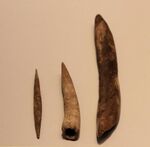Levantine Aurignacian
Topic: Social
 From HandWiki - Reading time: 4 min
From HandWiki - Reading time: 4 min
The Levantine Aurignacian (35,000-29,000 BP, calibrated, 32,000-26,000 BP, non-calibrated)[1] is an Upper Paleolithic culture of the Near-Eastern Levant.[1] It was named so because of the similarity of stone tools with the Aurignacian culture in Europe.[1] The Levantine Aurignacian used to be called Lower and Upper Antelian in old sources, from the site of Wadi Antelias in Lebanon.[1]
Levantine Aurignacian period
Similarities with Aurignacian are found in the manufacture of blades and in the processing of bone tools.[1]
The Levantine Aurignacian follows chronologically the Emiran and Early Ahmarian in the same area of the Near East, and closely related to them.[2]
The carving of a horse with traces of a layer of ocher painting from Hayonim Cave, now in the Israel Museum, is generally categorized as Aurignacian and variously dated to 40,000-18,500 BP.[3][4][5][6] This may be one of the earliest known manifestation of human art, together with the ocher pieces of Blombos Cave, before the outpouring of parietal art in Europe.[7]
The Levantine Aurignacian is part of the technological shift from Middle Paleolithic to Upper Paleolithic, but the arrival of modern humans Homo sapiens in the Levant still predates the Levantine Aurignacian by tens of thousands of years.[8] The earliest Upper Paleolithic entity is the local Ahmarian, with the first full-fledged blade/bladelet technology, to which the Levantine Aurignacian succeeds, possibly after a few thousand years of co-existence.[8] The Emiran period and the Ahmarian period form the very first periods of the Upper Paleolithic, corresponding to the first stages of the expansion of Homo sapiens out of Africa.[9] From this stage, the first modern humans probably migrated to Europe to form the beginning of the European Upper Paleolithic, including the Aurignacian culture.[9] There is a possibility that the Levantine Aurignacian was the result of reverse influence from the European Aurignacian, but this remains unsettled.[8]
Next period: the Kebaran microlithic culture
By the end of the Levantine Aurignacian, gradual changes took place in stone industries. The first phase of the Epipalaeolithic Near East, also known as Kebaran, lasts from 20,000 to 12,150 BP.[10] Small stone tools called microliths and retouched bladelets can be found for the first time. The microliths of this culture period differ greatly from the Aurignacian artifacts.
Sites
| The Paleolithic |
|---|
| ↑ Pliocene (before Homo) |
| ↓ Mesolithic |
- Central Negev sites D14, D18, D22, D27 A,B[11]
- El-Quseir[11]
- Hayonim Cave D[11]
- Kebara Cave D[11]
- Ksar Akil, shelter VII[11]
- Raqefet Cave, level III-IV[11]
- Umm el Tlel[11]
Artifacts
References
- ↑ 1.0 1.1 1.2 1.3 1.4 Shea, John J. (2013) (in en). Stone Tools in the Paleolithic and Neolithic Near East: A Guide. Cambridge University Press. pp. 154-155. ISBN 9781107006980. https://books.google.com/books?id=Bq7NAedu4gQC&pg=PA154.
- ↑ Shea, John J. (2013) (in en). Stone Tools in the Paleolithic and Neolithic Near East: A Guide. Cambridge University Press. p. 154. ISBN 9781107006980. https://books.google.com/books?id=Bq7NAedu4gQC&pg=PA154.
- ↑ Yiśraʼel (Jerusalem), Muzeʼon; Museum (Jerusalem), Israel (1986) (in en). Treasures of the Holy Land: Ancient Art from the Israel Museum. Metropolitan Museum of Art. p. 29. ISBN 9780870994708. https://books.google.com/books?id=KPVTCRYPfFMC&pg=PA29.
- ↑ "Horse from Hayonim Cave, Israel, 30,000 years" in (in en) Israel Museum Studies in Archaeology. Samuel Bronfman Biblical and Archaeological Museum of the Israel Museum. 2002. p. 10. https://books.google.com/books?id=w7NtAAAAMAAJ.
- ↑ "Hayonim horse". https://museums.gov.il/en/items/Pages/ItemCard.aspx?IdItem=ICMS_IMJ_330094.
- ↑ Bar-Yosef, Ofer; Belfer-Cohen, Anna (1981). The Aurignacian at Hayonim Cave. pp. 35-36. https://www.persee.fr/doc/paleo_0153-9345_1981_num_7_2_4296.
- ↑ Sale, Kirkpatrick (2006) (in en). After Eden: The Evolution of Human Domination. Duke University Press. p. 57. ISBN 9780822339380. https://books.google.com/books?id=2q9780EgEBEC&pg=PA57.
- ↑ 8.0 8.1 8.2 Williams, John K. (2006). "The Levantine Aurignacian: a closer look". Lisbon: Instituto Português de Arqueologia (Trabalhos de Arqueologia Bar-Yosef O, Zilhão J, editors. Towards a definition of the Aurignacian. 45): 317-352. http://www.patrimoniocultural.gov.pt/media/uploads/trabalhosdearqueologia/45/20.pdf.
- ↑ 9.0 9.1 Klein, Richard G. (2009). The Human Career: Human Biological and Cultural Origins. University of Chicago Press. p. 610. https://books.google.com/books?id=vSgCAAAAQBAJ&pg=PA610.
- ↑ Simmons, 47-48
- ↑ 11.0 11.1 11.2 11.3 11.4 11.5 11.6 Shea, John J. (2013) (in en). Stone Tools in the Paleolithic and Neolithic Near East: A Guide. Cambridge University Press. pp. 150-151. ISBN 9781107006980. https://books.google.com/books?id=Bq7NAedu4gQC&pg=PA150.
Bibliography
- Simmons, Alan H., The Neolithic Revolution in the Near East: Transforming the Human Landscape, 2007, University of Arizona Press, ISBN:978-0816529667, google books
 |
 KSF
KSF


